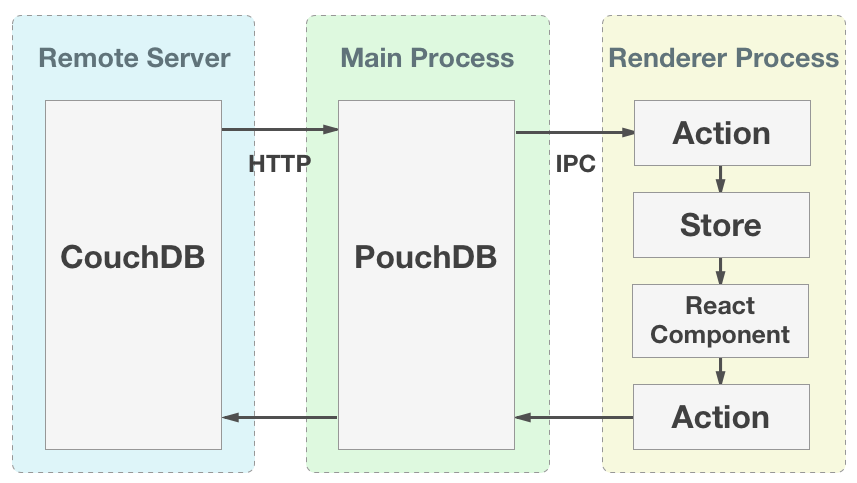Accessing the local database
There are two databases in local and on remote and they sync via HTTP(S). The Inkdrop client app is built on top of a PouchDB for storing data in local and syncing with the remote database. For many parts of the application, the database is the source of truth.
Data is written to the local database first, then synced with the remote database, and changes to the database trigger Actions, Stores and components to refresh their contents. The illustration below shows this flow of data:

Accessing the data from plugins (Recommended)
There is a class called InkdropDatabase which wraps PouchDB and provides a bunch of useful methods that help you access the local database for managing notes, notebooks, tags and images.
For example, below code gets data directly from the local database:
const db = inkdrop.main.dataStore.getLocalDB()
// Get a note data by note ID
const note = await db.notes.get('note:F8xUp-23G')
// Get all notebooks
const books = await db.books.all()
// Get notes in a notebook
const notesInBook = await db.notes.findInBook(books[0]._id)
// Search notes with keywords
const result = await db.utils.search('Foobar')
const { docs } = result
console.log('Search result:', docs)
NOTE: Returned objects from the database represent
Remote Objects
. They can be converted into plain objects by calling
structuredClone(remoteObj).
Data Access
Notes
Learn about the note model and the note class, which provide the core functionality for handling notes.
Notebooks
Notebooks are how notes are organized in Inkdrop and are commonly used to separate notes by category, project, or purpose.
Tags
Tags let you add keywords to notes, making them easier to find and browse when you've got a lot of them.
Local HTTP server
The Inkdrop client app can open a simple HTTP server so that you can access the data from an external program easily.
Accessing via HTTP (Advanced)

The Inkdrop client app can open a simple HTTP server so that you can access the data from an external program easily, which gives you a flexible ability to import/export your notes.
You can configure the HTTP server settings by editing config.json in the user data directory
Quit Inkdrop, then edit it like so:
{
"*": {
"core": {
"server": {
"enabled": true,
"port": 19840,
"bindAddress": "127.0.0.1",
"auth": { "username": "foo", "password": "bar" }
}
}
}
}
Now, launch the app.
Configurations
core.server.enabled- Specifytrueto enable the HTTP server. Default isfalse.core.server.port- Defines the port number to listen. Default is19840.core.server.bindAddress- Defines the IP address to listen. Default is127.0.0.1.core.server.auth.{username,password}- Defines Basic auth credentials.
API reference
See the local HTTP server reference for more details.
Accessing the PouchDB instance (Advanced, not recommended)
There is a global variables named inkdrop which allows you to access the internal objects of Inkdrop.
It has main property, which is a reference to the inkdrop instance in the main process.
To access the local PouchDB instance in the main process:
async function getDatabaseInfo() {
const db = inkdrop.main.dataStore.localPouch
const info = await db.info()
console.log(info.db_name)
}
In this code, localPouch is the instance of PouchDB.
Be careful, you could break your database by accessing it with PouchDB since its API does not protect you from breaking it.
Use it only if the data access API does not provide what you would do.
NOTE: Returned objects from the database represent Remote Objects .